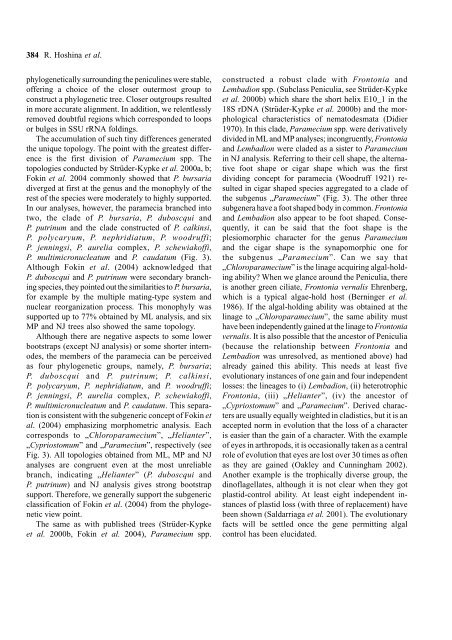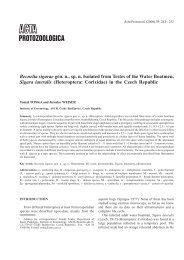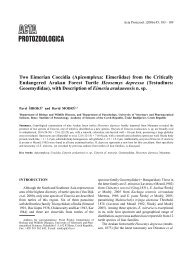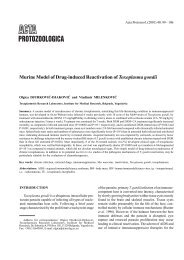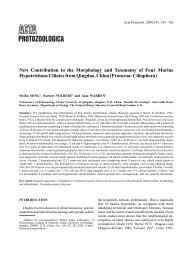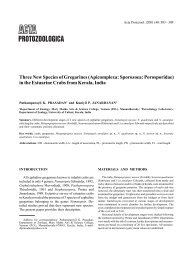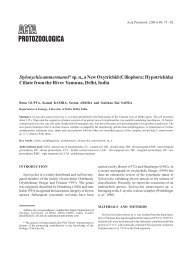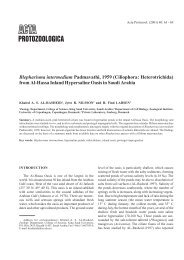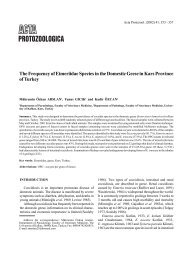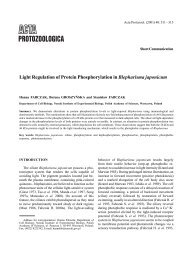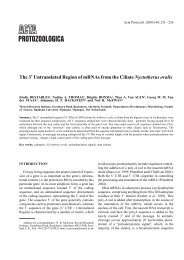Intraspecific Genetic Divergence of Paramecium ... - CiteSeerX
Intraspecific Genetic Divergence of Paramecium ... - CiteSeerX
Intraspecific Genetic Divergence of Paramecium ... - CiteSeerX
Create successful ePaper yourself
Turn your PDF publications into a flip-book with our unique Google optimized e-Paper software.
384 R. Hoshina et al.<br />
phylogenetically surrounding the peniculines were stable,<br />
<strong>of</strong>fering a choice <strong>of</strong> the closer outermost group to<br />
construct a phylogenetic tree. Closer outgroups resulted<br />
in more accurate alignment. In addition, we relentlessly<br />
removed doubtful regions which corresponded to loops<br />
or bulges in SSU rRNA foldings.<br />
The accumulation <strong>of</strong> such tiny differences generated<br />
the unique topology. The point with the greatest difference<br />
is the first division <strong>of</strong> <strong>Paramecium</strong> spp. The<br />
topologies conducted by Strüder-Kypke et al. 2000a, b;<br />
Fokin et al. 2004 commonly showed that P. bursaria<br />
diverged at first at the genus and the monophyly <strong>of</strong> the<br />
rest <strong>of</strong> the species were moderately to highly supported.<br />
In our analyses, however, the paramecia branched into<br />
two, the clade <strong>of</strong> P. bursaria, P. duboscqui and<br />
P. putrinum and the clade constructed <strong>of</strong> P. calkinsi,<br />
P. polycaryum, P. nephridiatum, P. woodruffi;<br />
P. jenningsi, P. aurelia complex, P. schewiak<strong>of</strong>fi,<br />
P. multimicronucleatum and P. caudatum (Fig. 3).<br />
Although Fokin et al. (2004) acknowledged that<br />
P. duboscqui and P. putrinum were secondary branching<br />
species, they pointed out the similarities to P. bursaria,<br />
for example by the multiple mating-type system and<br />
nuclear reorganization process. This monophyly was<br />
supported up to 77% obtained by ML analysis, and six<br />
MP and NJ trees also showed the same topology.<br />
Although there are negative aspects to some lower<br />
bootstraps (except NJ analysis) or some shorter internodes,<br />
the members <strong>of</strong> the paramecia can be perceived<br />
as four phylogenetic groups, namely, P. bursaria;<br />
P. duboscqui and P. putrinum; P. calkinsi,<br />
P. polycaryum, P. nephridiatum, and P. woodruffi;<br />
P. jenningsi, P. aurelia complex, P. schewiak<strong>of</strong>fi,<br />
P. multimicronucleatum and P. caudatum. This separation<br />
is consistent with the subgeneric concept <strong>of</strong> Fokin et<br />
al. (2004) emphasizing morphometric analysis. Each<br />
corresponds to „Chloroparamecium”, „Helianter”,<br />
„Cypriostomum” and „<strong>Paramecium</strong>”, respectively (see<br />
Fig. 3). All topologies obtained from ML, MP and NJ<br />
analyses are congruent even at the most unreliable<br />
branch, indicating „Helianter” (P. duboscqui and<br />
P. putrinum) and NJ analysis gives strong bootstrap<br />
support. Therefore, we generally support the subgeneric<br />
classification <strong>of</strong> Fokin et al. (2004) from the phylogenetic<br />
view point.<br />
The same as with published trees (Strüder-Kypke<br />
et al. 2000b, Fokin et al. 2004), <strong>Paramecium</strong> spp.<br />
constructed a robust clade with Frontonia and<br />
Lembadion spp. (Subclass Peniculia, see Strüder-Kypke<br />
et al. 2000b) which share the short helix E10_1 in the<br />
18S rDNA (Strüder-Kypke et al. 2000b) and the morphological<br />
characteristics <strong>of</strong> nematodesmata (Didier<br />
1970). In this clade, <strong>Paramecium</strong> spp. were derivatively<br />
divided in ML and MP analyses; incongruently, Frontonia<br />
and Lembadion were claded as a sister to <strong>Paramecium</strong><br />
in NJ analysis. Referring to their cell shape, the alternative<br />
foot shape or cigar shape which was the first<br />
dividing concept for paramecia (Woodruff 1921) resulted<br />
in cigar shaped species aggregated to a clade <strong>of</strong><br />
the subgenus „<strong>Paramecium</strong>” (Fig. 3). The other three<br />
subgenera have a foot shaped body in common. Frontonia<br />
and Lembadion also appear to be foot shaped. Consequently,<br />
it can be said that the foot shape is the<br />
plesiomorphic character for the genus <strong>Paramecium</strong><br />
and the cigar shape is the synapomorphic one for<br />
the subgenus „<strong>Paramecium</strong>”. Can we say that<br />
„Chloroparamecium” is the linage acquiring algal-holding<br />
ability When we glance around the Peniculia, there<br />
is another green ciliate, Frontonia vernalis Ehrenberg,<br />
which is a typical algae-hold host (Berninger et al.<br />
1986). If the algal-holding ability was obtained at the<br />
linage to „Chloroparamecium”, the same ability must<br />
have been independently gained at the linage to Frontonia<br />
vernalis. It is also possible that the ancestor <strong>of</strong> Peniculia<br />
(because the relationship between Frontonia and<br />
Lembadion was unresolved, as mentioned above) had<br />
already gained this ability. This needs at least five<br />
evolutionary instances <strong>of</strong> one gain and four independent<br />
losses: the lineages to (i) Lembadion, (ii) heterotrophic<br />
Frontonia, (iii) „Helianter”, (iv) the ancestor <strong>of</strong><br />
„Cypriostomum” and „<strong>Paramecium</strong>”. Derived characters<br />
are usually equally weighted in cladistics, but it is an<br />
accepted norm in evolution that the loss <strong>of</strong> a character<br />
is easier than the gain <strong>of</strong> a character. With the example<br />
<strong>of</strong> eyes in arthropods, it is occasionally taken as a central<br />
role <strong>of</strong> evolution that eyes are lost over 30 times as <strong>of</strong>ten<br />
as they are gained (Oakley and Cunningham 2002).<br />
Another example is the trophically diverse group, the<br />
din<strong>of</strong>lagellates, although it is not clear when they got<br />
plastid-control ability. At least eight independent instances<br />
<strong>of</strong> plastid loss (with three <strong>of</strong> replacement) have<br />
been shown (Saldarriaga et al. 2001). The evolutionary<br />
facts will be settled once the gene permitting algal<br />
control has been elucidated.


